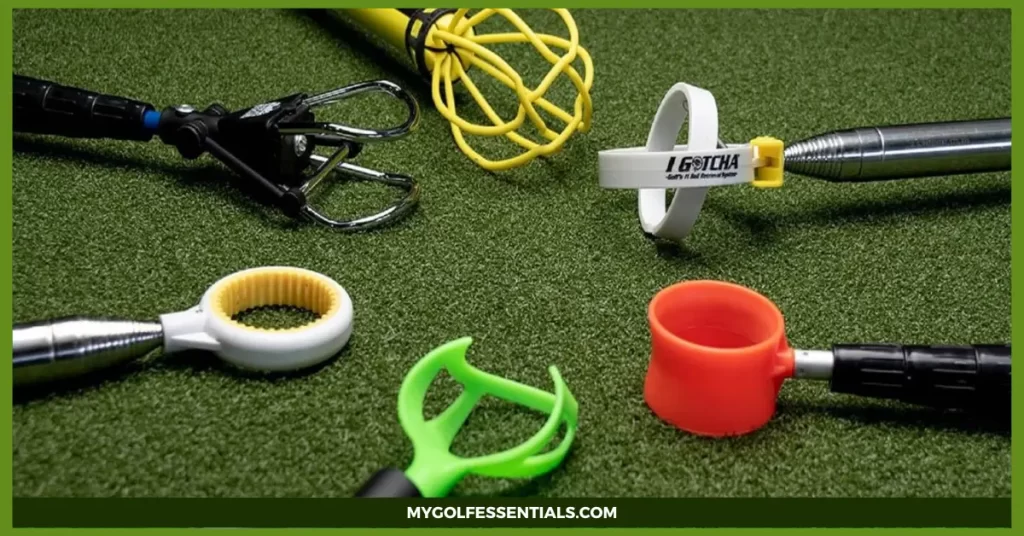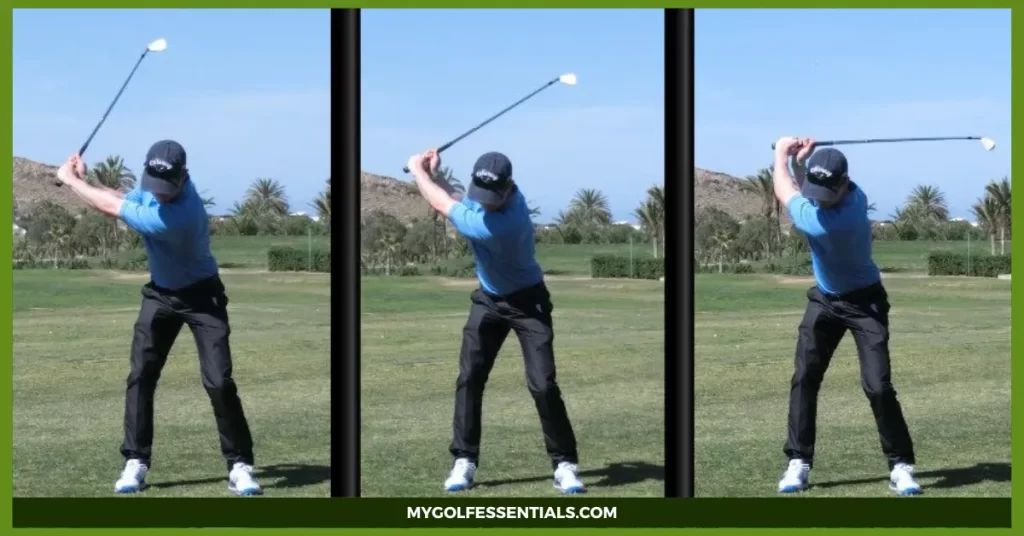
Do you want to improve your golf backswing and dominate the course? It takes practice, planning, and preparation to improve your backswing to maximize power, accuracy, and distance with each shot.
This blog post will help you learn the key elements of a successful golf backswing so you can soon conquer courses in such a way as never before. We’ll review essential tips from posture to wrist and arm in the same position while discussing drills designed to sharpen technique. Read on for all the info needed to boost your game!
Understanding the Basics of a Golf Backswing
The golf backswing is one of the most important parts of the game. A consistent and well-executed backswing can improve accuracy and increase power when hitting the ball. Understanding the basics of a golf backswing to optimize your game is important.
A good golf backswing starts with a proper grip. The grip should be relaxed and comfortable, with the left hand lower than the right hand on the club (for a right-handed golfer). Make sure you position your hands to square to the target line.
The next step in a golf backswing is to take the club away from the ball in one fluid motion. During the takeaway, keep your arms straight and swing sequence the club away from the ball while keeping your head down and eyes on the ball. As you move back in the playing golf, allow your left arm to rotate a little more than your right arm, as this will help create some natural lag for an effective downswing later on.
Getting the proper grip on your golf club
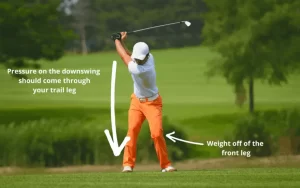
The grip is one of the most important elements in developing a successful golf backswing. While there are many variations, the “Vardprofessional golfers commonly use on” or overlapping grip is most eve this grip:
1. Place your left hand on the club first and wrap your fingers around it so the thumb points down the club.
2. Place your right hand on the club overlapping your left thumb so the two thumbs sit side by side. Your right pinky should rest in between your left index and middle fingers.
3. Make sure there is a slight pressure from both hands with a gentle grip pressure- not too tight, or it will inhibit the free motion of your arms during the backswing.
With a proper grip on your club, you are ready to begin your golf backswing. Remember to keep your chin up and maintain good posture throughout your swing.
Hips Remain in the Box
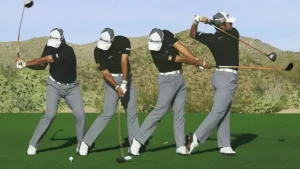
One of the most important aspects of a successful golf backswing is to keep your hips in the box throughout the motion. This means your hips should stay relatively level while winding up for your swing and not move excessively from side to side.
Keeping your hips in the “box” helps maintain your center of gravity, and all the power you generate propels your clubhead toward the ball. To get the most out of your backswing, practicing keeping your hips aligned with where they started during the winding-up motion is important. This will help you maintain balance and power as you contact the ball.
Another important aspect of keeping your hips in the “box” is not rushing through the backswing motion. Taking too much time will cause your muscles to fatigue and reduce power output, whereas taking too little time can result in a wild swing with poor control over where the ball goes.
It’s important to practice the backswing motion until you find a comfortable rhythm that will allow your body to generate maximum power while providing good control over where the ball goes.
By mastering how to keep your hips in the box during a golf backswing, you can ensure that you are making clean contact with the ball and that your clubhead is traveling in the right direction. If you take the time to practice this motion, it will pay off with improved accuracy and power for every swing.
Hips Rotate during the Backswing
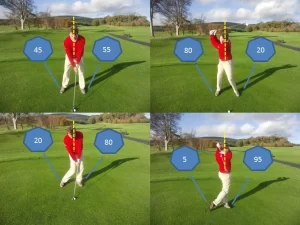
The hips are the core of the golf swing, and proper rotation is essential for a powerful backswing. During the backswing, your hips should rotate away from the ball to create room to turn your body against it. To do this, you need to shift your weight onto your right foot while at the same time rotating your hips away from the target.
This should create a coiling action in your torso, allowing you to generate more power as you swing back. As you reach the top of your backswing, your right shoulder should be lower than your left, with most of your weight on your right foot and hips rotating toward the target. By rotating properly throughout the backswing, you can create more power and control the direction of your shot.
Left Knee Points at the Ball during the Backswing

During a golf backswing, the left knee is one of the most important parts of your body. The left knee should point directly at the ball as you take the club away from the ball and begin your backswing. This will help ensure that you create enough power in your swing to get maximum distance from each shot and help keep your balance and stay centered throughout the swing.
When setting up the ball, ensure your feet are shoulder-width apart and pointing straight in line with the target. As you start your backswing, focus on turning your shoulders away from the ball while slightly pivoting away with your hips.
Keep your body weight on the inside of your left foot as you do this. Your left knee should stay pointed in the ball’s direction throughout the backswing, which will help you generate power and maintain balance.
Right Knee Retains Some Flex
The right knee should remain slightly flexed throughout the golf backswing. Keeping the right knee soft is important for creating a proper weight shift during your swing. When you take your club back, maintain some flex in your right knee and keep it pointed towards the target. This will ensure you are in the correct posture as you make your way through the backswing.
Your left knee should remain slightly flexed as you take your club back. This helps to ensure that your weight stays centered throughout the swing and prevents bad habits from forming during the motion. Staying balanced will help you make a more consistent and powerful golf shot every time.
Practicing your golf backswing with the proper knee position is important to promote good muscle memory. You can make a reliable and powerful swing each time with consistent practice. Keep your right knee slightly flexed and pointed toward your target as you take your club back and begin the downswing.
Setting up for a successful backswing
Learning to play great golf backswing is key to improving your game. When it comes to mastering the backswing, there are a few key elements that you should keep in mind.
The first step is ensuring your body and swing are properly set up before taking a shot. This means checking for comfort and stability in your stance, ensuring your feet are correctly placed, and you have a good grip on the club. It would be best to be mindful of how your arms and body are positioned; having them too low or too high can affect the outcome of the swing.
Another important aspect is timing. A successful backswing requires mastering coordination between upper and lower body movements. It would be best to practice slowly taking your backswing, allowing yourself time to develop the appropriate rhythm and tempo for a good swing.
Finally, it would be best to consider adding power to your swing. This can be done by using your hips as a pivot point and engaging your legs to help generate momentum. You can increase your power and accuracy when combined with the other elements of a good backswing.
Proper form and technique during the perfect backswing
The golf backswing is an integral part of any successful shot. Proper form and technique during the backswing will help you maximize your power, accuracy, and consistency on the course. When taking a backswing, keep your head still and look at the ball as you lift the club away from it. This keeps your eyes on the target, allowing you to swing more accurately.
Maintain a narrow stance with your feet slightly wider than shoulder-width apart. This will help you keep your balance throughout the backswing. Keep your chest up and shoulders square as you turn away from the ball rather than allowing them to rotate around it. Your arms should stay connected to your torso, allowing you to control the club throughout the motion.
Keep your upper arms close to your body as they move away from the ball. This gives you greater leverage and control over the club. Keep a light grip on the club with your hands slightly ahead of the ball. As you swing back, allow your hands to move slightly, but keep them connected with the club throughout the motion.
Timing is key when transitioning from back to front swing
Amateur golfers must ensure good timing when transitioning from the backswing to the front swing. It is important to start the downswing in sync with the turn of your body, as this can give you a great foundation for a powerful and accurate swing.
When beginning your backswing, ensure that your arms and body move smoothly and synchronize. As you reach the top of your backswing, pause to steady your swing before continuing into the downswing.
To ensure good timing during the transition from back to front swing, try focusing on the rhythm of your golf swing. Each move helps to feel the weight shifting from the right to the left foot. Syncing your upper body turn and club release will help create a consistent swing speed, leading to greater accuracy and power in your shots.
Good timing during the transition is essential for creating a powerful shot that travels further while remaining accurate. By ensuring good rhythm and synchronizing your arms and body movements, you can give yourself the best chance to hit a great shot.
Common mistakes to avoid when executing a golf backswing
1. Don’t use too much arm: Most golfers rely heavily on their arms during the backswing, which can cause an over-the-top swing and result in a loss of power and accuracy. To maximize the potential of your drive, focus on using your body to create momentum rather than relying solely on your arms.
2. Don’t lift your head too soon: Keeping your head down and eyes focused on the ball is one of the most important aspects of a successful backswing, but unfortunately, many golfers lift their heads too soon in anticipation of the impact. Lifting the head prematurely can ruin your posture and cause an inaccurate shot. Keep your head still and down until the backswing is completed.
3. Don’t rotate too much: Many golfers think a bigger shoulder turn will create more power, but this isn’t always true. Too much rotation can cause an incorrect swing plane and loss of balance, ultimately leading to inaccurate shots. Instead, focus on making a smooth shoulder turn and finish the backswing with your weight evenly distributed between both feet.
4. Don’t be too quick: A rushed backswing can result in the clubhead moving faster than your body can keep up, causing an inaccurate shot. Take your time during the backswing and keep your body in sync with the club shaft.
By keeping these mistakes in mind, you can ensure that your golf backswing is successful and powerful every time. ‘You’ll be on your way to a better scorecard with practice and focus. Good luck!
FAQs
How do I execute a proper golf backswing?
Clubhead speed, timing, and balance are the keys to executing a proper golf backswing. Start by taking your grip and ensuring your hands are in the correct position. Once you’ve done this, take a deep breath before beginning the swing. As you initiate the swing, make sure that you coil your body and rotate your hips to build power.
Are there any common mistakes to avoid when doing a golf backswing?
Yes, there are some common mistakes that you should try to avoid. Poor posture is one of the most frequent causes of errors in the backswing. Additionally, an overly-wide backswing can disrupt your balance and lead to further issues with the rest of your swing.
What are some of the benefits of a proper golf backswing?
A properly executed golf backswing helps you generate more power and accuracy in your shots. It will also increase club head speed, allowing you to hit the ball farther. A good backswing helps you maintain balance throughout your swing, enabling you to hit consistent shots.
What are the best drills for improving my backswing?
There are several drills and exercises you can use to improve your backswing. One good exercise is to practice setting up with your feet shoulder-width apart and ensure that your spine is straight. Another drill involves practicing the half-backswing, where you take a few good golf swing without completing the full swing path.
Conclusion
I hope this article has given you a better understanding of the different types of golf backswings. Knowing the basics and differences between each type can help you decide which is right for your game. Regardless of which you choose, remember that practice makes perfect! You will become an expert in no time with consistent practice and repetition.

